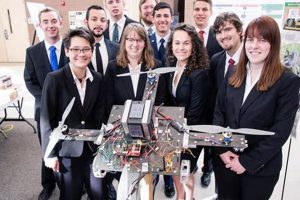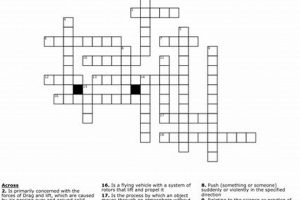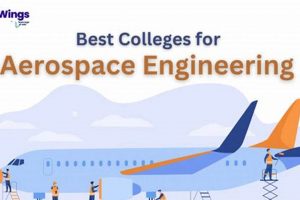The process of acquiring the skills, knowledge, and credentials required for a career designing, developing, and testing aircraft, spacecraft, satellites, and missiles necessitates a rigorous academic foundation. This typically begins with a bachelor’s degree in aerospace engineering or a closely related field such as mechanical engineering with a specialization in aerospace. Foundational coursework includes mathematics (calculus, differential equations, linear algebra), physics (classical mechanics, thermodynamics, electromagnetism), and computer science (programming, data analysis).
The significance of a robust educational background stems from the complex nature of the field. Aerospace engineers apply principles from multiple disciplines to solve intricate problems related to aerodynamics, propulsion, materials science, and control systems. A strong theoretical understanding, coupled with practical experience gained through laboratory work and internships, prepares aspiring engineers to contribute to advancements in air and space travel, defense technology, and scientific exploration. Historically, the demand for highly educated aerospace engineers has driven advancements in curriculum development and research, leading to continuous improvements in the quality of engineering programs worldwide.
Further details concerning specific degree requirements, specialized areas of study within aerospace engineering, and the role of continuing education in career advancement will be explored in subsequent sections. These aspects are vital for those pursuing a career path in this demanding and rewarding profession.
Guidance for Aspiring Aerospace Engineers
The attainment of expertise in aerospace engineering demands careful planning and a strategic approach to education. The following recommendations can assist individuals navigating the academic pathway towards a successful career in this field.
Tip 1: Strengthen Mathematical Foundations: A solid understanding of calculus, differential equations, and linear algebra is paramount. These mathematical tools are fundamental to solving engineering problems. Dedicate significant time to mastering these concepts.
Tip 2: Cultivate a Strong Physics Background: Grasp the principles of classical mechanics, thermodynamics, and fluid dynamics. Aerospace engineering relies heavily on physics to understand and predict the behavior of aircraft and spacecraft.
Tip 3: Develop Proficiency in Computer Programming: Learn programming languages such as Python or MATLAB. These tools are essential for simulations, data analysis, and control system design. Early exposure and consistent practice are critical.
Tip 4: Seek Relevant Internships: Gain practical experience through internships at aerospace companies or research institutions. Real-world exposure provides invaluable insights and networking opportunities. Actively pursue such opportunities.
Tip 5: Focus on Specialization: Choose a specific area of interest within aerospace engineering, such as aerodynamics, propulsion, or structural analysis. Specialization allows for deeper knowledge and expertise in a particular domain.
Tip 6: Participate in Engineering Projects: Engage in hands-on engineering projects, such as designing and building model aircraft or rockets. These projects provide practical application of theoretical knowledge and foster problem-solving skills.
Tip 7: Join Professional Organizations: Membership in organizations like the American Institute of Aeronautics and Astronautics (AIAA) provides access to resources, networking opportunities, and industry insights.
Adherence to these recommendations will significantly enhance an individual’s preparedness for the challenges and opportunities inherent in a career in aerospace engineering. A proactive and focused approach to education is crucial for success.
The subsequent sections will explore advanced degree options and the importance of lifelong learning in maintaining a competitive edge in the ever-evolving aerospace industry.
1. Mathematical proficiency
Mathematical proficiency forms a cornerstone of the educational foundation for aspiring aerospace engineers. The ability to apply mathematical principles is integral to understanding and solving complex engineering problems inherent in the design, analysis, and operation of aerospace systems. A robust mathematical skillset enables engineers to model physical phenomena, optimize designs, and ensure the safety and reliability of aerospace vehicles.
- Calculus for Aerospace Applications
Calculus, encompassing differential and integral calculus, provides the tools to analyze rates of change and accumulate quantities, crucial for understanding aerodynamic forces, fluid flow, and the dynamic behavior of aircraft and spacecraft. For instance, calculating lift and drag coefficients requires integration techniques, while analyzing the stability of flight control systems relies on differential equations. A comprehensive grasp of calculus is thus essential for predicting and controlling the performance of aerospace vehicles.
- Linear Algebra for System Analysis
Linear algebra provides the framework for analyzing and solving systems of linear equations, essential for modeling and simulating complex aerospace systems. Structural analysis, vibration analysis, and control system design rely heavily on linear algebra to represent and solve for the behavior of interconnected components. Understanding eigenvectors and eigenvalues, for example, is critical for determining the stability characteristics of an aircraft under various flight conditions.
- Differential Equations for Dynamic Systems
Differential equations are fundamental for modeling the dynamic behavior of aerospace vehicles and their subsystems. From the motion of a rocket through the atmosphere to the control of a satellite’s orientation in space, differential equations provide the mathematical language to describe and predict these systems’ evolution over time. Proficiency in solving differential equations is therefore crucial for designing and controlling the performance of aerospace systems.
- Numerical Methods for Computational Solutions
Many aerospace engineering problems lack analytical solutions and require numerical methods for approximation. Numerical methods, such as finite element analysis and computational fluid dynamics, leverage computational power to solve complex equations that describe the behavior of aerospace systems. Proficiency in numerical methods enables engineers to analyze structural stresses, simulate aerodynamic flows, and optimize designs with a high degree of accuracy.
In summary, mathematical proficiency, encompassing calculus, linear algebra, differential equations, and numerical methods, is not merely a prerequisite but a fundamental toolset for aerospace engineers. It enables them to analyze, design, and optimize aerospace systems, ensuring their performance, safety, and reliability. The depth and breadth of mathematical knowledge directly correlate with an engineer’s ability to tackle the complex challenges inherent in the field.
2. Physics fundamentals
The mastery of physics fundamentals constitutes an indispensable element of the educational foundation necessary for aspiring aerospace engineers. The principles of physics govern the behavior of aircraft, spacecraft, and related technologies; therefore, a deep understanding of these principles is crucial for successful design, analysis, and operation. The correlation between comprehension of physics and competence in aerospace engineering is direct: a strong grasp of physics enables engineers to predict, control, and optimize the performance of complex aerospace systems. For example, Newton’s laws of motion are foundational for understanding flight dynamics and control, while thermodynamics is critical for the design of efficient propulsion systems.
Furthermore, a thorough grounding in fluid mechanics is essential for understanding aerodynamic forces acting on aircraft and spacecraft, enabling the design of airfoils and control surfaces that maximize lift and minimize drag. Similarly, knowledge of electromagnetism is vital for designing communication systems, navigation systems, and electrical power systems for aerospace vehicles. Quantum mechanics, while perhaps less directly applicable in some areas, contributes to the understanding of materials science, crucial for developing lightweight and high-strength materials used in aerospace structures. The application of physics extends beyond theoretical understanding to practical problem-solving, enabling engineers to address challenges such as minimizing fuel consumption, enhancing aircraft stability, and ensuring the safety and reliability of space missions.
In essence, physics fundamentals are not merely a component of the required curriculum, but the very bedrock upon which aerospace engineering expertise is built. The absence of a solid foundation in physics inevitably limits an engineer’s capacity to innovate, solve problems, and contribute meaningfully to the advancement of aerospace technology. Thus, the rigor and depth of physics education directly impact the potential for success in the field, reinforcing the critical link between fundamental knowledge and applied engineering practice.
3. Engineering design principles
The systematic application of engineering design principles is a core element of the educational foundation required for aerospace engineers. These principles, representing a structured approach to problem-solving, ensure that designs are not only functional but also safe, efficient, and economically viable. The integration of design principles into aerospace engineering curricula prepares students to address complex challenges throughout the product lifecycle, from initial conceptualization to final implementation and maintenance.
- Requirements Analysis and Definition
This initial phase involves a thorough understanding of the project’s objectives, constraints, and performance metrics. Aerospace engineers must translate broad objectives into specific, measurable, achievable, relevant, and time-bound (SMART) requirements. For instance, designing a new aircraft wing requires clearly defined requirements for lift, drag, structural integrity, and weight. This process directly informs the subsequent design stages and ensures that the final product meets the intended needs. A well-defined set of requirements is the foundation for a successful design.
- Conceptual Design and Trade Studies
This phase involves generating multiple potential design concepts and evaluating their feasibility through trade studies. Aerospace engineers explore various design options, considering factors such as materials, aerodynamics, propulsion systems, and control systems. For example, trade studies for a new satellite might compare different propulsion methods based on fuel efficiency, thrust, and operational lifespan. This iterative process identifies the most promising concepts that align with the project requirements and constraints.
- Detailed Design and Analysis
The selected concept undergoes detailed design, involving the creation of precise specifications, drawings, and models. Advanced analytical techniques, such as finite element analysis (FEA) and computational fluid dynamics (CFD), are employed to simulate the performance of the design under various operating conditions. For instance, detailed analysis of a rocket nozzle ensures that it can withstand extreme temperatures and pressures. This phase validates the design’s structural integrity, aerodynamic performance, and thermal management capabilities before physical prototyping.
- Testing and Validation
The final design undergoes rigorous testing and validation to verify that it meets the specified requirements. Prototypes are subjected to a variety of tests, including wind tunnel tests, structural load tests, and flight tests. For example, an aircraft prototype undergoes extensive flight testing to evaluate its performance under various weather conditions and flight maneuvers. This iterative process identifies any design flaws or areas for improvement before the product is released for production. Testing and validation are critical for ensuring the safety and reliability of aerospace systems.
The application of these engineering design principles, from initial requirements analysis to final testing and validation, ensures that aerospace engineers develop systems that are not only technologically advanced but also safe, efficient, and reliable. The integration of these principles into the aerospace engineering curriculum is essential for preparing graduates to meet the challenges of the industry and contribute to the advancement of aerospace technology.
4. Software applications
Proficiency in diverse software applications is an indispensable component of the educational foundation required for a career in aerospace engineering. The complexity of modern aerospace systems necessitates the use of specialized software tools for design, analysis, simulation, and control. Familiarity with these applications enables engineers to efficiently and accurately address the challenges inherent in the development and operation of aircraft, spacecraft, and related technologies.
- Computer-Aided Design (CAD) Software
CAD software, such as CATIA, SolidWorks, and AutoCAD, enables engineers to create detailed 2D and 3D models of aerospace components and systems. These models serve as the basis for manufacturing, assembly, and documentation. Proficiency in CAD software is crucial for designing aircraft wings, fuselage structures, engine components, and satellite systems. These skills allow for the precise definition of geometry and facilitate collaboration among design teams.
- Computational Fluid Dynamics (CFD) Software
CFD software, including ANSYS Fluent and OpenFOAM, allows engineers to simulate the flow of air or other fluids around aerospace vehicles. These simulations provide insights into aerodynamic forces, heat transfer, and flow behavior, enabling the optimization of designs for performance and efficiency. CFD simulations are employed in the design of airfoils, engine inlets, and rocket nozzles, among other applications. Understanding CFD principles and software tools is essential for predicting and improving aerodynamic performance.
- Finite Element Analysis (FEA) Software
FEA software, such as ANSYS Mechanical and Abaqus, enables engineers to analyze the structural integrity of aerospace components under various loading conditions. FEA simulations provide insights into stress, strain, and deformation, allowing for the identification of potential failure points and the optimization of designs for strength and weight. FEA is used in the analysis of aircraft wings, fuselage structures, and landing gear, ensuring their ability to withstand the stresses of flight. A solid understanding of FEA principles and software is critical for ensuring the structural safety and reliability of aerospace systems.
- MATLAB and Simulink
MATLAB and Simulink are widely used in aerospace engineering for modeling, simulation, and control system design. MATLAB provides a powerful environment for numerical computation, data analysis, and algorithm development, while Simulink allows for the creation of dynamic system models and simulations. These tools are employed in the design of flight control systems, navigation systems, and signal processing algorithms. Proficiency in MATLAB and Simulink is essential for analyzing system performance, optimizing control strategies, and validating designs through simulation.
The ability to effectively utilize these and other specialized software applications is a critical skill for aerospace engineers. The curriculum of an aerospace engineering program must provide comprehensive training in these tools, enabling graduates to immediately contribute to the design, analysis, and development of advanced aerospace systems. Furthermore, continuous learning and adaptation to new software technologies are essential for maintaining a competitive edge in the rapidly evolving field of aerospace engineering.
5. Practical experience
Practical experience constitutes an indispensable element within the educational framework necessary for becoming a successful aerospace engineer. The theoretical knowledge acquired through coursework and academic study forms the foundation, but it is the application of this knowledge in real-world scenarios that solidifies understanding and cultivates essential problem-solving skills. A direct causal relationship exists: the more relevant and extensive the practical experience, the greater the engineer’s capacity to address complex challenges in the field.
Internships, co-op programs, and research projects offer opportunities to apply classroom learning to tangible problems. For instance, participating in a NASA-sponsored design competition provides students with the chance to conceive, design, and build a prototype spacecraft, simulating the demands of a professional engineering environment. Similarly, an internship at a commercial aircraft manufacturer exposes students to the complexities of aircraft design, testing, and certification, providing invaluable insights into industry practices. These experiences allow students to identify and address unforeseen challenges, refine their technical skills, and develop essential teamwork and communication abilities, which are often difficult to cultivate solely through academic study. Further, practical experience can lead to specialized expertise, making the student more valuable to potential employers.
In summary, practical experience serves as a critical bridge between theoretical knowledge and real-world application, significantly enhancing the educational foundation of an aerospace engineer. The challenges encountered and skills developed through internships, co-op programs, and research projects are essential for ensuring that graduates are well-prepared to contribute meaningfully to the field. Consequently, integrating robust practical experience opportunities into aerospace engineering curricula is of paramount importance for the future success of the profession. The lack of such opportunities can hinder the career growth of potential engineers.
Frequently Asked Questions
This section addresses common queries regarding the educational pathway to becoming a qualified aerospace engineer.
Question 1: Is a graduate degree necessary to secure employment in aerospace engineering?
While a bachelor’s degree in aerospace engineering (or a closely related field) is generally sufficient for entry-level positions, a graduate degree (Master’s or PhD) can enhance career prospects. Advanced degrees are often required for research positions, leadership roles, and specialized areas within the field.
Question 2: What are the most important undergraduate courses for aspiring aerospace engineers?
Core coursework includes calculus, differential equations, linear algebra, classical mechanics, thermodynamics, fluid dynamics, and computer programming. A strong foundation in these subjects is crucial for understanding advanced aerospace engineering topics.
Question 3: Is it possible to become an aerospace engineer with a degree in mechanical engineering?
Yes, a mechanical engineering degree with a specialization in aerospace or related areas can provide a pathway into the field. However, supplemental coursework in aerodynamics, spacecraft design, and propulsion may be necessary to acquire specialized knowledge.
Question 4: What role do internships play in aerospace engineering education?
Internships are highly valuable as they provide practical experience and exposure to real-world engineering challenges. Internships at aerospace companies, research institutions, or government agencies can significantly enhance career prospects and provide valuable networking opportunities.
Question 5: How important are software skills in aerospace engineering education?
Proficiency in software applications such as CAD (Computer-Aided Design), CFD (Computational Fluid Dynamics), and FEA (Finite Element Analysis) is essential. These tools are used extensively in the design, analysis, and simulation of aerospace systems.
Question 6: What resources are available to help fund an aerospace engineering education?
Numerous scholarships, grants, and loans are available to students pursuing aerospace engineering degrees. Professional organizations, government agencies, and universities offer financial aid programs to support students in this field. Diligent research and application are crucial for securing these resources.
The educational path to becoming an aerospace engineer requires dedication, rigorous study, and continuous learning. The information presented here provides a general overview of the key considerations.
The following section provides a comprehensive overview of relevant professional organizations and online resources.
Conclusion
The preceding sections have detailed the multifaceted nature of the education needed to be an aerospace engineer. It has been shown that a robust academic foundation, encompassing mathematics, physics, and engineering design principles, is paramount. Equally important is the development of proficiency in relevant software applications and the acquisition of practical experience through internships and research projects. The successful navigation of this educational path demands dedication, perseverance, and a strategic approach to learning.
As the aerospace industry continues to evolve, so too must the educational preparedness of its engineers. A commitment to lifelong learning and adaptation to emerging technologies is essential for sustained success in this demanding and rewarding field. Prospective aerospace engineers are encouraged to diligently pursue the rigorous academic and practical experiences outlined, ensuring they are well-equipped to contribute to the future of aerospace innovation. The advancement of air and space travel, defense technology, and scientific exploration depends on the expertise and dedication of well-educated aerospace engineers.







